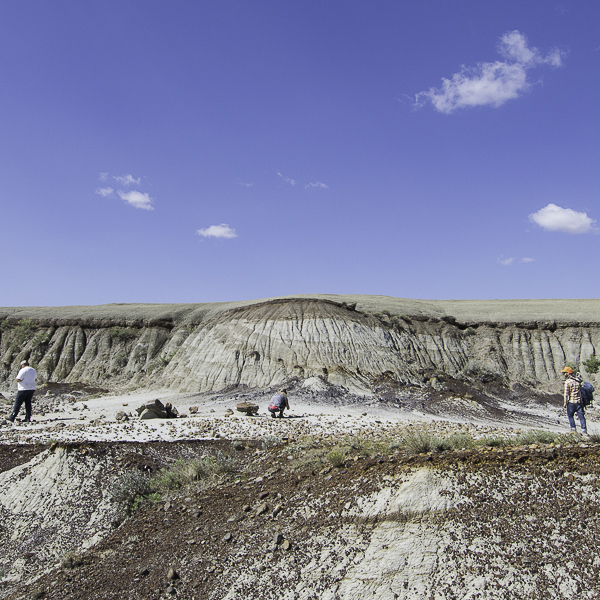There’s bones in them there hills: Fossil Finding in the Badlands

written by: Mary Paquet, Intern, ROM Paleontology
How do you go about finding a dinosaur? It’s the best kind of treasure hunt. The thrill, the satisfaction, the excitement of finding a fossil is something not everyone gets to experience.
The Royal Ontario Museums’s very own Dr. David Evans, Senior Curator of Vertebrate Palaeontology, and Michael Ryan, Curator of Vertebrate Palaeontology at the Cleveland Museum of Natural History partnered together 15 years ago to create the Southern Alberta Dinosaur Project (SADP). It is a research project shared between the ROM, CMNH, and the Royal Tyrell Museum. They have been spending their summers in the dry and scorching badlands of southern Alberta, unearthing fossils and digging for more information to piece together the world of dinosaurs that used to roam the earth.
![[Digging_up_dinosaurs_in_the_Southern_Alberta_Badlands_(left to right)_David_Evans,_Cary_Woodroffe,_Victoria_Arbour]](/sites/default/files/imce/mtp_rompalaeo_20170806_009.jpg)
Digging up dinosaurs in the Southern Alberta Badlands (left to right Dr. David Evans, Cary Woodroffe. Photo credit: Mary Paquet
There are spectacular dinosaur specimens that have been found in Drumheller and Dinosaur Provincial Park, but SADP is looking to make discoveries farther afield. Dinosaur Provincial Park is dense with amazing specimens of dinosaur skeletons. In fact, 400 different intact skeletons specimens have been found there over the past 100 years. By looking outside of the park where less field work has been done (south of Medicine Hat and into Montana), they hope to uncover enough information to help piece together how paleontological ecosystems and populations adjusted to changing environments. The overarching goal of this project is to better understand the biostratigraphy of the Southern Alberta area. Over the years David and Michael have discovered and described several new species.

Left to right, Michael Ryan, Wendy Sloboda, Dr. David Evans. Photo credit: Mary Paquet
By looking at large scale evolutionary patterns, work in the Evans lab here at the ROM, they aim to investigate dinosaurs’ response to environmental and climactic changes. By comparing their observations of the changing world of dinosaurs leading up to the end-Cretaceous extinction event, this research has the potential to help us understand how current populations, communities and ecosystems might respond to our climate and biodiversity crisis.

Tools of the trade. Photo credit: Mary Paquet.
However, before any of this research can be done, the team must first find the fossils. I was lucky enough to follow along this summer and document the field work of these palaeontologists. The two weeks I spent with SADP were a crash course in palaeontology, and here’s what I learned:
To find a fossil, you first have to start with an understanding of the geology of the area. It’s a matter of knowing where fossils might be in the geological layer, and looking there. Each layer is like a chapter in a book - telling the stories of our evolving planet. In the badlands of Southern Alberta, the layers of rock are exposed, having been carved away by years of erosion. To find dinosaurs, palaeontologists and prospectors go out hiking, and once they’ve placed themselves in the right geological time scale by examining the rocks, scanning the ground is the next step. Most skeletons that are discovered are found because they are partially exposed on the surface of the rock. So palaeontologists begin by looking for bone fragments. It takes your eye a while to be able to differentiate between what is just a rock, what is a bone or what is a tooth. Fossils have a different colour and texture than the rock around them. Depending on how weathered they are, bones may be lighter than the rock and often have a striated or porous texture, whereas teeth can be shiny and darker in colour. It’s really just about scanning the ground and looking for things that stick out (I mean visually, but sometimes the bones literally do stick out). I spent a few days holding up rocks, roots, and one time a cow hoof and asking “Is this a fossil?!” to whichever palaeontologist was closest to me. At the end of my two weeks with SADP I was proudly able to differentiate between what was a fossil and what wasn’t.

Can you spot the fossils in this photo? There are four visible bones. (left to right, Ashley Reynolds and Jade Simon). Photo credit: Mary Paquet

To the untrained eye, this Euoplocephalus skull blends in with the rock around it. The lighter part is where the bone was exposed on the side of the hill. Photo credit: Mary Paquet.
Some people dedicate their lives to fossil finding, whether it be as an academic palaeontologist or as a prospector with a passion. Wendy Sloboda, namesake of the ROM’s very own Wendiceratops, is a main player in the Southern Alberta Dinosaur Project. She’s a famous fossil hunter in the paleontological community. A “force of nature” as David accurately describes her. Wendy grew up in Southern Alberta, she knows the land well, and seems to have a supernatural ability for finding fossils. She will set out for the day looking for fossils, and come back with bags of cool fossil treasures, and maybe even a couple of potential dig sites plugged into her GPS for future SADP field seasons. She prospects for the skeletons, and SADP digs them up. It was Wendy that found the Euoplocephalus skull SADP recently uncovered.

Wendy Sloboda out prospecting for fossils. Photo credit: Mary Paquet
If you’ve ever wanted to find some fossils yourself, consider signing up for a dig experience with the Royal Tyrell Museum next summer. Get your hands dirty and feel the thrill of fossil finding!
Mary is currently an Environmental Visual Communications student at the ROM. For her summer placement she joined the ROM Palaeontology team in Alberta to document life in the field.
